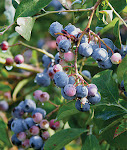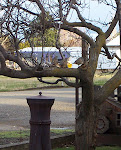A few years ago I bought some large blueberry plants and then didn't get a spot opened up to plant them. They did ok in the pots for a couple of years, then I planted in their forever home and they promptly went to heck! One died and the other two are just struggling along. So here I am years later and have finally did what I should have done in the first place, reading about they care and feeding of blueberries! Yes, sometimes I am a slow learner at times.
Last year, realizing that the two struggling blueberries would either be too large for the spot they are in or finally die, I bought a bush variety, Northsky, that can live in pots. They were planted in a combination of potting soil, peat moss and steer manure (sterilized) and did very well last summer.
Northsky Blueberry "Vaccinium"
Half-High Blueberry fruiting mid-season.
Full Description
Northsky is the most cold-hardy of all blueberries and can survive extreme winter conditions. The compact bushes that carry a snow load without damage to the branches.Lower growing plant habit is particularly well suited for container growing, borders or group plantings. The bush grows 2-3 feet wide and begins spring completely covered in snow-white blooms. Fruits are small is size but with fresh wild flavor.
Spread
24-36 inches
- Do not fertilize newly planted bushes until they have leafed out. Work a fertilizer designed for acid-loving plants (10-10-10 or Osmocoat controlled release) into the top 3 inches of soil around each plant. Apply again 4-6 weeks later. After the first year, fertilize in spring as new growth begins, and again 4-6 weeks later. Apply fertilizer to the soil beneath each bush, keeping it 5-6 inches away from the main stem.
- Do not water as frequently after early September unless the soil is very dry.
- Mulch after the ground freezes in fall to prevent root damage from alternating freezing and thawing.
- Mulch with 2-3 inches of compost of pine needles to retain moisture and prohibit weed growth.
 |
| Northsky Blueberry |







